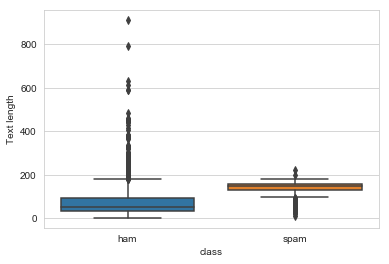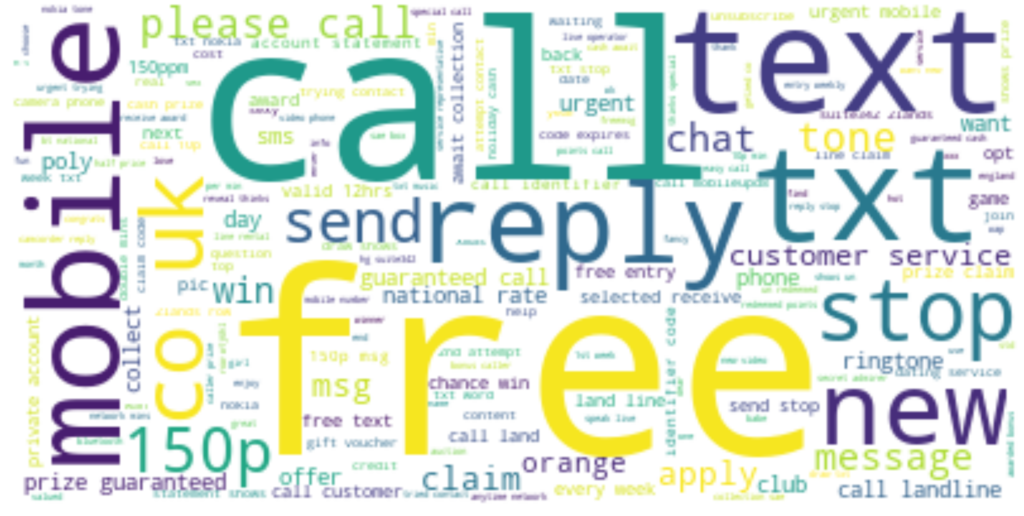Spams is a cost-effective method for advertisement. Only a very small fraction of the recipients may get interested in the product, but this is a big problem for most users. Spammers collect recipients contact from publicly accessible sources and make use of this medium to advertise their products. At present more than 95% of the emails sent are believed to be spam and this makes spams a severe problem.
To avoid this, is it possible to detect Spam using machine learning?
Let us look at a dataset of spam sms by UCI 1 and see if we can use the power of machine learning to detect spams!
Table of Contents
1) Descriptive Statistics
2) Exploratory data analysis
3) Machine Learning
4) Summary
[showhide type="post"]
from IPython.display import display
from IPython.display import HTML
import IPython.core.display as di # Example: di.display_html('<h3>%s:</h3>' % str, raw=True)
# This line will hide code by default when the notebook is exported as HTML
di.display_html('<script>jQuery(function() {if (jQuery("body.notebook_app").length == 0) { jQuery(".input_area").toggle(); jQuery(".prompt").toggle();}});</script>', raw=True)
# This line will add a button to toggle visibility of code blocks, for use with the HTML export version
di.display_html('''<button onclick="jQuery('.input_area').toggle(); jQuery('.prompt').toggle();">Toggle code</button>''', raw=True)
#Importing the required libraries import numpy as np import pandas as pd import seaborn as sns import matplotlib.pyplot as plt from sklearn import feature_extraction from sklearn.naive_bayes import MultinomialNB from sklearn.model_selection import GridSearchCV from sklearn.base import BaseEstimator, TransformerMixin from sklearn.pipeline import Pipeline from sklearn import metrics import warnings warnings.filterwarnings("ignore") %matplotlib inline from collections import Counter from nltk.tokenize import RegexpTokenizer from stop_words import get_stop_words import nltk from nltk.corpus import stopwords from nltk import sent_tokenize, word_tokenize
#We will read the spam sms datasetand perform some EDA df = pd.read_csv('spam.csv',encoding='latin-1') df = df.iloc[:,0:2] df.columns = ['class' , 'Text']
df.head()
[/showhide]
Descriptive Statistics
We have a sms dataset containing spams and ham. The goal is to predict whether the text is a spam or not using machine learning. We will make use of Natural language processing techniques train a model and perform spam detection.
| class | Text | |
|---|---|---|
| 0 | ham | Go until jurong point, crazy.. Available only … |
| 1 | ham | Ok lar… Joking wif u oni… |
| 2 | spam | Free entry in 2 a wkly comp to win FA Cup fina… |
| 3 | ham | U dun say so early hor… U c already then say… |
| 4 | ham | Nah I don’t think he goes to usf, he lives aro… |
The dataset consist of text message along with the information whether it is a spam or not.
Exploratory data analysis

We can see most of the sms are genuine messages while some are spams. Let us look if there is a relationship between the length of a message and the type of message.

Spam messages are longer than genuine messages on average, interesting!Let us visualize this with a boxplot.

On average genuine messages are shorter than spams, but we can see it is not always the case as we can see a lot of outliers for ham.
Let us find the most frequetly used words in spam and ham messages
Let us clean the data first by removing stop words. Stop words usually refers to the most common words in a language which are mostly grammar words that wouldn’t be useful for this text analysis. Let us have a look at the most common stop words.
['a', 'about', 'above', 'after', 'again', 'against', 'all', 'am', 'an', 'and', 'any', 'are', "aren't", 'as', 'at', 'be', 'because', 'been', 'before', 'being', 'below', 'between', 'both', 'but', 'by', "can't", 'cannot', 'could', "couldn't", 'did']
These words are unnecessary for the analysis and we just eliminate them.
Let us look at the top 15 words that are present is a genuine message

We can see that genuine messages have commonly used words in a normal text message. The most common word is .. which are called ellipsis indicating a pause or silence and is very commonly used in texting. Other words in the bar plot are words that are commonly used in a normal conversation.

We can see the most common words are call, free, cash, prize or winning and is so different from the bar plot we saw for genuine messages. Maybe these differences are detected by machine learning models to distinguish between a spam and a genuine message.
Let us visualize the most commonly used words for a spam message in a word cloud.

Machine Learning
Let us make use of machine learning to predict whether a message is a spam or ham
While creating a model we need to make sure that it is good in detecting spams but more importantly the model should never classify a genuine message as a spam. It means it should should have a low false positive rate!
If a spam is classied as normal message is fine but it should be the other way around! An important message should never go to the spam folder.
We will make use of pipelining and gridsearch in order to take advantage of cross validation and train a model with the focus on precision so that there is a low false positive rate.
GridSearchCV(cv=3, error_score='raise-deprecating',
estimator=Pipeline(memory=None,
steps=[('pre', PreProcessing()), ('cv', CountVectorizer(analyzer='word', binary=False, decode_error='strict',
dtype=<class 'numpy.int64'>, encoding='utf-8', input='content',
lowercase=True, max_df=1.0, max_features=None, min_df=1,
ngram_ra...nizer=None, vocabulary=None)), ('clf', MultinomialNB(alpha=1.0, class_prior=None, fit_prior=True))]),
fit_params=None, iid='warn', n_jobs=None,
param_grid={'clf__alpha': array([ 1, 4, 7, 10, 13, 16, 19, 22, 25, 28])},
pre_dispatch='2*n_jobs', refit=True, return_train_score='warn',
scoring='accuracy', verbose=0)
Let us look at the predictions on the Test dataset.
| class | Text | Text length | prediction | |
|---|---|---|---|---|
| 2 | 1 | Free entry in 2 a wkly comp to win FA Cup fina… | 155 | 1 |
| 17 | 0 | Eh u remember how 2 spell his name… Yes i di… | 81 | 0 |
| 18 | 0 | Fine if thatåÕs the way u feel. ThatåÕs the wa… | 58 | 0 |
| 37 | 0 | I see the letter B on my car | 28 | 0 |
| 40 | 0 | Pls go ahead with watts. I just wanted to be s… | 82 | 0 |
| 46 | 0 | Didn’t you get hep b immunisation in nigeria. | 45 | 0 |
| 48 | 0 | Yeah hopefully, if tyler can’t do it I could m… | 67 | 0 |
| 57 | 0 | Sorry, I’ll call later in meeting. | 34 | 0 |
| 61 | 0 | Ha ha ha good joke. Girls are situation seekers. | 48 | 0 |
| 65 | 1 | As a valued customer, I am pleased to advise y… | 153 | 1 |
Let us calculate the accuracy of our model
| Predicted Not spam | Predicted Spam | |
|---|---|---|
| Actual not spam | 1194 | 4 |
| Actual spam | 16 | 179 |
Hence we have achieved 98.56% accuracy in detecting whether a message is a spam or not.
Summary
Thus we have performed analysis on the UCI sms dataset. We can see how machine interprets text data and create a classier based on how we train a model.
We also saw how important is cleaning and the use of countvectorizer to convert a collection of textual data into a matrix of token counts. This is important as a machine would not understand the meaning of a word. But if it classifies the word according to the frequency it can create a mathematical model that has the same meaning as that of the text document.
Also we saw that spam detections should should have a low false positive rate, that means if a spam is classied as a normal message it is bad but its worse if its the other way around! An important message should never go to the spam folder.
1. Data Source: https://archive.ics.uci.edu/ml/datasets/sms+spam+collection



